
Raffaello Sanzio da Urbino, now generally known in English as Raphael, was an Italian painter and architect of the High Renaissance. His work is admired for its clarity of form, ease of composition, and visual achievement of the Neoplatonic ideal of human grandeur. Together with Leonardo da Vinci and Michelangelo, he forms the traditional trinity of great masters of that period.
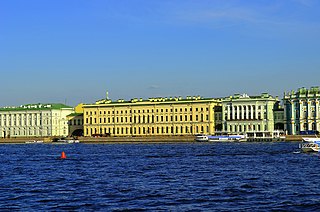
The State Hermitage Museum is a museum of art and culture in Saint Petersburg, Russia. It was founded in 1764 when Empress Catherine the Great acquired a collection of paintings from the Berlin merchant Johann Ernst Gotzkowsky. The museum celebrates the anniversary of its founding each year on 7 December, Saint Catherine's Day. It has been open to the public since 1852. The Art Newspaper ranked the museum 10th in their list of the most visited art museums, with 2,812,913 visitors in 2022.
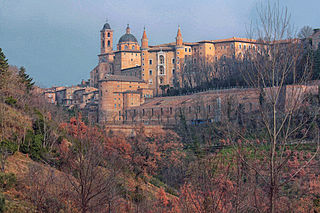
Urbino is a comune (municipality) in the Italian region of Marche, southwest of Pesaro, a World Heritage Site notable for a remarkable historical legacy of independent Renaissance culture, especially under the patronage of Federico da Montefeltro, duke of Urbino from 1444 to 1482.

The Venus of Urbino is an oil painting by Italian painter Titian, depicting a nude young woman, traditionally identified with the goddess Venus, reclining on a couch or bed in the sumptuous surroundings of a Renaissance palace. Work on the painting seems to have begun anywhere from 1532 or 1534, and was perhaps completed in 1534, but not sold until 1538. It is currently held in the Galleria degli Uffizi in Florence.
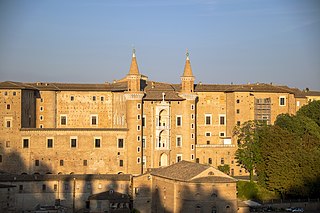
The Ducal Palace is a Renaissance building in the Italian city of Urbino in the Marche. One of the most important monuments in Italy, it is listed as UNESCO World Heritage Site since 1998.

Giovanni Santi was an Italian painter and decorator, father of Raphael Sanzio. He was born in 1435 at Colbordolo in the Duchy of Urbino. He studied under Piero della Francesca and was influenced by Fiorenzo di Lorenzo. He was court painter to the Duke of Urbino and painted several altarpieces among other things. He died in Urbino.
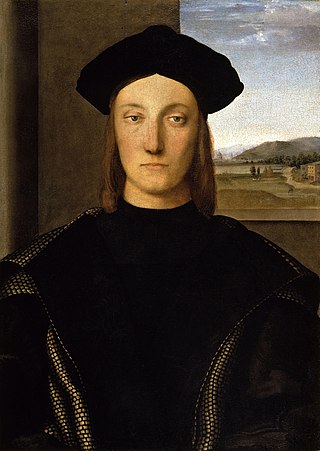
Guidobaldoda Montefeltro, also known as Guidobaldo I, was an Italian condottiero and the Duke of Urbino from 1482 to 1508.

The Alba Madonna is a tondo (circular) oil on wood transferred to canvas painting by the Italian High Renaissance artist Raphael, created c. 1511, depicting Mary, Jesus, and John the Baptist in a typical Italian countryside.

The Garvagh Madonna is an oil painting by the Italian Renaissance artist Raphael, dating to c. 1509–1510. It depicts the Virgin, the Christ Child and the infant John the Baptist, and is one of many paintings by Raphael with this trio. It is from early in the artist's third, or Roman period, in which distinctive changes are seen from his Umbrian or Florentine period in style and use of colour, with the introduction of more natural subjects and settings.

The Mond Crucifixion or Gavari Altarpiece is an oil on poplar panel dated to 1502–1503, making it one of the earliest works by Italian Renaissance artist Raphael, perhaps the second after the c.1499-1500 Baronci Altarpiece. It originally comprised four elements, of which three survive, now all separated: a main panel of the Crucified Christ with the Virgin Mary, Saints and Angels which was bequeathed to the National Gallery, London, by Ludwig Mond, and a three-panel predella from which one panel is lost; the two surviving panels are Eusebius of Cremona raising Three Men from the Dead with Saint Jerome's Cloak in the Museu Nacional de Arte Antiga, in Lisbon, and Saint Jerome saving Silvanus and punishing the Heretic Sabinianus in the North Carolina Museum of Art.

Portrait of Elisabetta Gonzaga is an oil on wood painting attributed to the Italian Renaissance artist Raphael, completed c. 1504–1505, and today housed in the Uffizi Gallery, Florence.

Saint George or Saint George and the Dragon is a small painting by the Italian Renaissance artist Raphael, executed c. 1503–1505. It is housed in the Louvre in Paris. A later version of the same subject is the Saint George and the Dragon in the National Gallery of Art in Washington, D.C.

The Tribuna of the Uffizi (1772–1778) by Johan Zoffany is a painting of the north-east section of the Tribuna room in the Uffizi in Florence, Italy. The painting is part of the United Kingdom's Royal Collection.

The Brera Madonna is a painting by the Italian Renaissance master Piero della Francesca, executed in 1472–1474. It is housed in the Pinacoteca di Brera of Milan, where it was deposited by Napoleon.
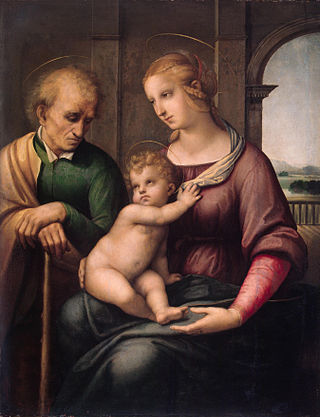
The Madonna with Beardless Saint Joseph is an early painting by Raphael, executed c. 1506, now at the Hermitage Museum. It depicts Saint Joseph, the Virgin Mary, and the Christ Child.

The Niccolini-Cowper Madonna, also known as the Large Cowper Madonna, is a painting by the Italian High Renaissance artist Raphael, depicting Mary and Jesus Christ as the Christ Child, against a blue sky.

The Small Cowper Madonna is a painting by the Italian High Renaissance artist Raphael, depicting Mary and Child, in a typical Italian countryside. It has been dated to around 1504–1505, the middle of the High Renaissance.
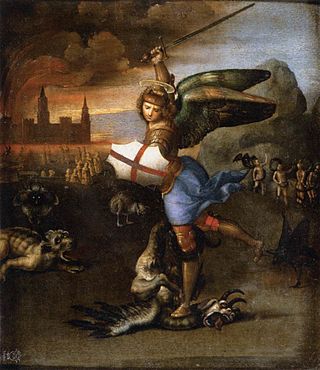
Saint Michael is an oil painting by the Italian artist Raphael. Also called the Little Saint Michael to distinguish it from a larger, later treatment of the same theme, Saint Michael Vanquishing Satan, it is now in the Louvre in Paris. The work depicts the Archangel Michael in combat with the demons of Hell, while the damned suffer behind him. Together with the Saint George, it represents the first of Raphael's works on martial subjects.

The Portrait of Guidobaldo da Montefeltro is a picture by the Italian Renaissance artist Raphael, dating from around 1506 and housed in the Uffizi Gallery, Florence. It portrays Guidobaldo da Montefeltro, duke of Urbino.

The Pinacoteca Comunale ofCittà di Castello is the main museum of paintings and arts of Umbria Italian Region, alongside the Perugia's National gallery, and it's housed in a renaissance palace, generally preserved in its original form.





















